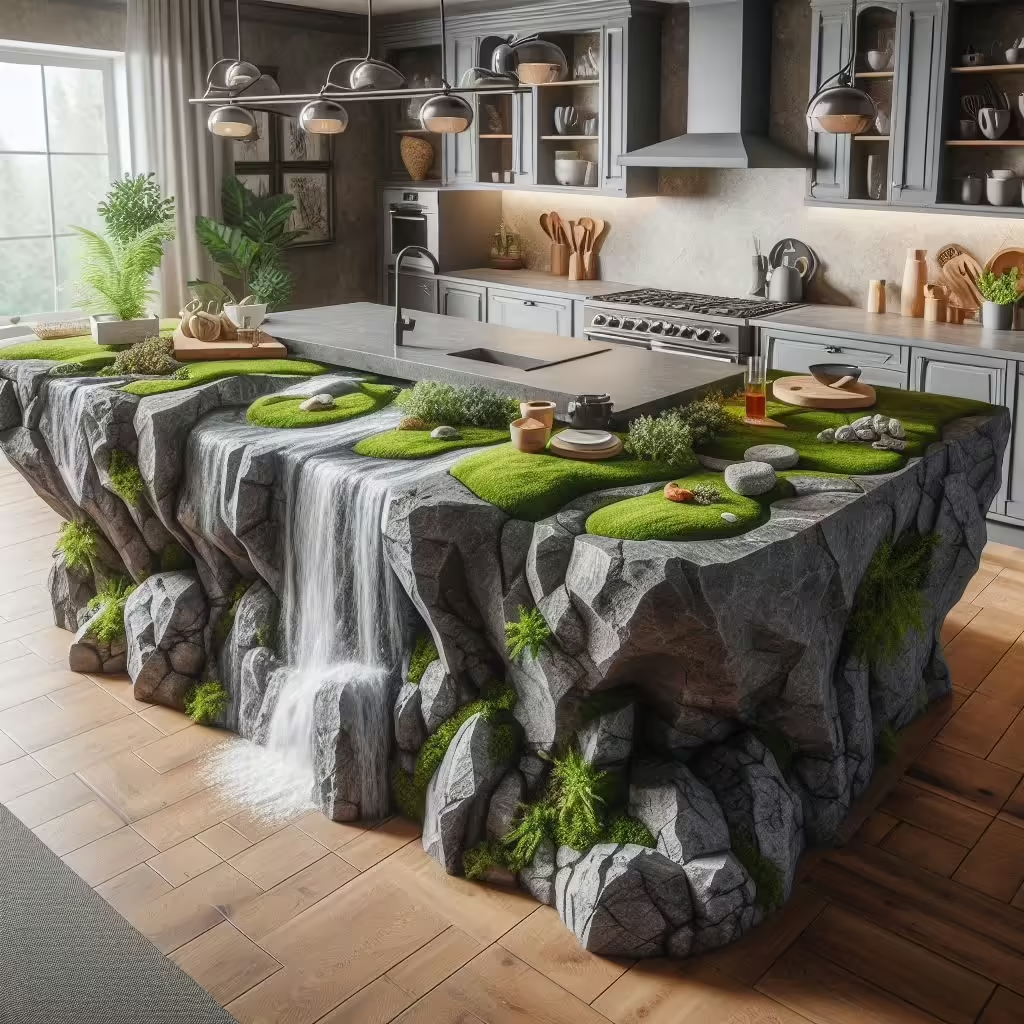The kitchen is often the heart of the home, and a well-designed kitchen island can be its centerpiece. One design trend that has been gaining popularity is the waterfall shaped kitchen island. This sleek and modern feature can transform your kitchen into a space of luxury and functionality. In this comprehensive guide, we’ll delve into what makes the waterfall shaped kitchen island so special, how to choose the right materials, design considerations, and how to make the most of this stunning feature in your home.
What is a Waterfall Shaped Kitchen Island?
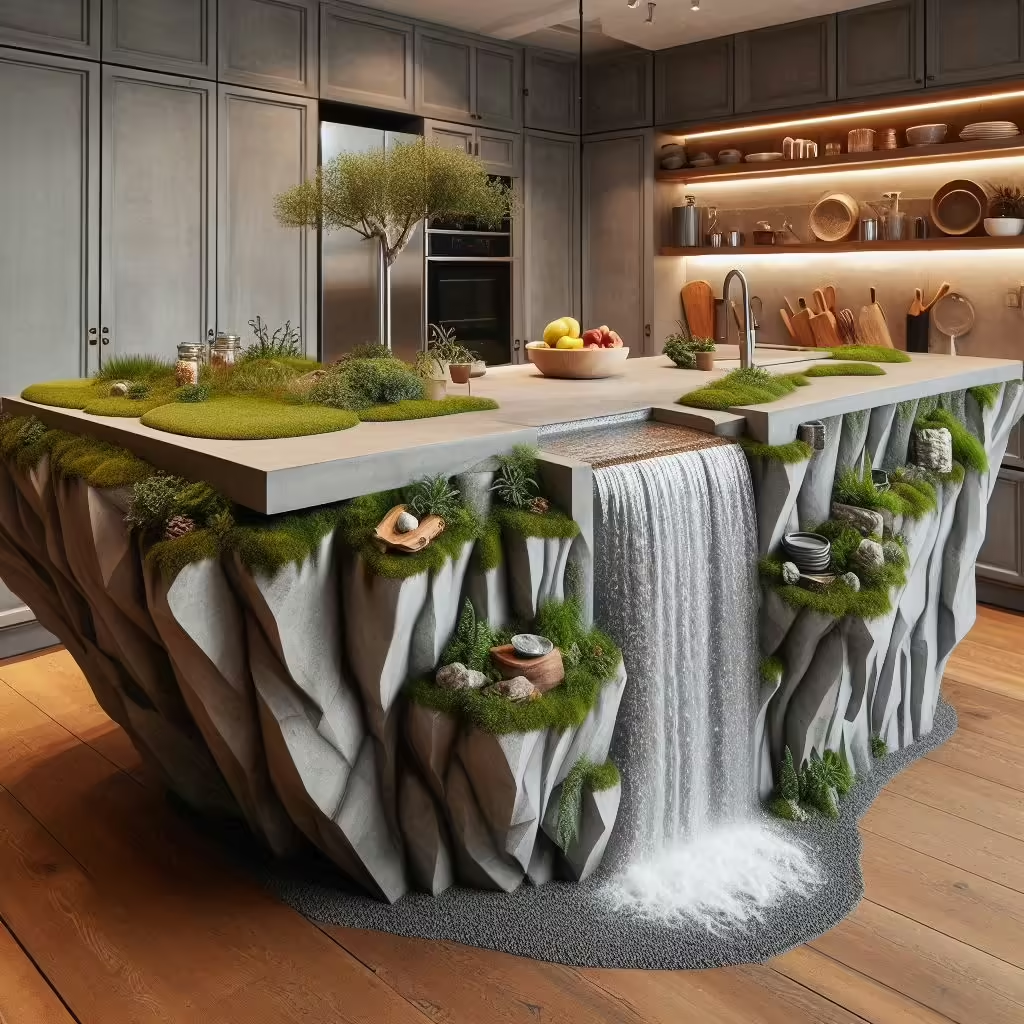
A waterfall shaped kitchen island is a design where the countertop material seamlessly flows over the sides of the island, extending down to the floor. This creates a continuous surface that mimics the look of a waterfall, hence the name. Unlike traditional kitchen islands that have a distinct horizontal surface, the waterfall island features a smooth and uninterrupted line that adds a touch of elegance and modernity to the kitchen space.
Key Features of a Waterfall Shaped Kitchen Island
- Seamless Design: The main characteristic of a waterfall shaped kitchen island is its seamless design. The countertop material extends from the top of the island down to the sides, creating a cohesive and flowing look.
- Versatile Aesthetic: It works well in various kitchen styles, from modern and minimalist to rustic and traditional. The key is to choose the right material and finish that complements your kitchen’s overall design.
- Functional Space: Besides being visually stunning, waterfall kitchen islands also serve as functional spaces for food prep, dining, and storage.
- Durable Construction: Since the sides of the island are often subject to wear and tear, waterfall islands are typically constructed with durable materials that can withstand daily use.
Benefits of a Waterfall Shaped Kitchen Island
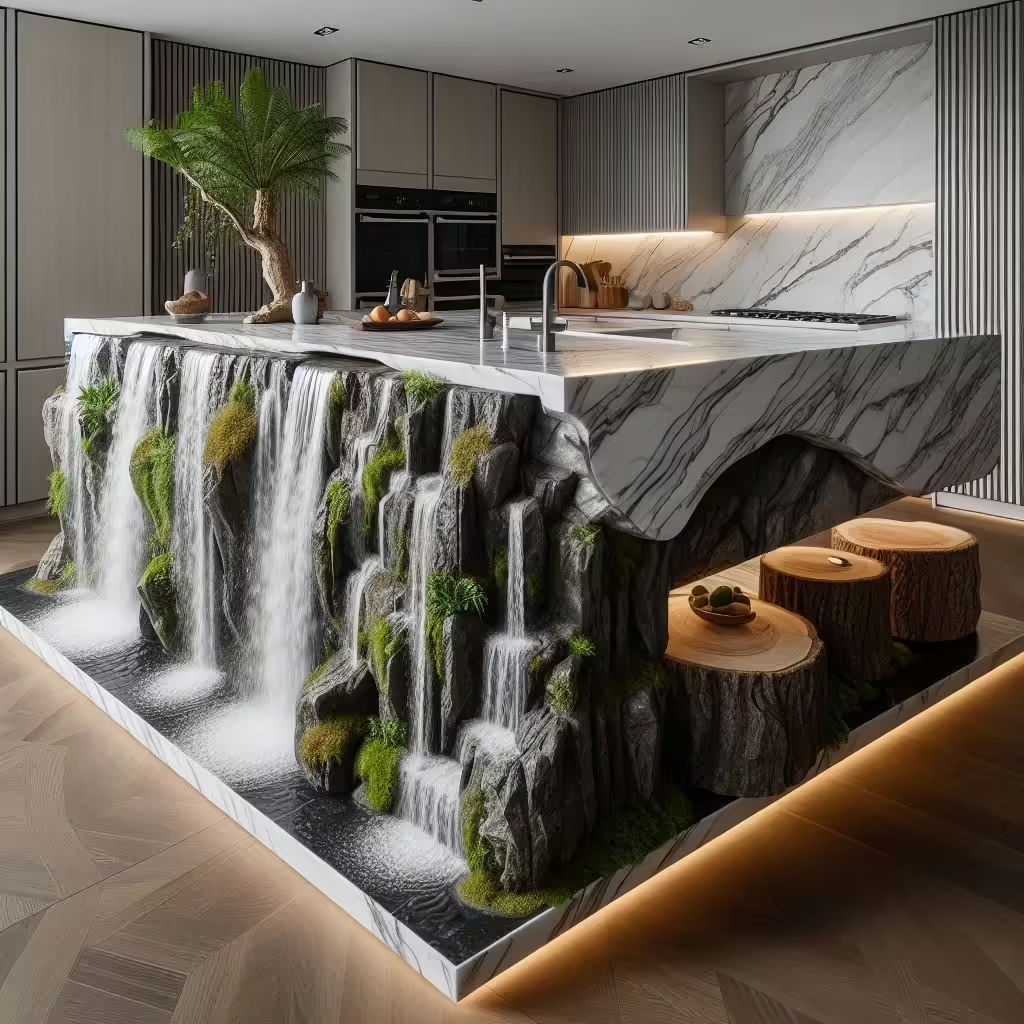
Enhanced Visual Appeal
One of the main reasons homeowners choose a waterfall shaped kitchen island is for its aesthetic appeal. The continuous line of the countertop creates a sleek and modern look that can instantly elevate the style of any kitchen. It serves as a statement piece that draws the eye and can make a kitchen feel more cohesive and well-designed.
Increased Durability
The waterfall design not only looks beautiful but also adds a layer of protection to your kitchen island. By extending the countertop material down the sides, you protect the cabinetry from potential damage caused by spills, bumps, and scratches. This is especially beneficial in busy kitchens where the island sees a lot of activity.
Versatile Design Options
Waterfall shaped kitchen islands are incredibly versatile. They can be customized to fit any kitchen size, layout, or style. Whether you prefer a modern, minimalist kitchen with a sleek quartz waterfall island or a more rustic look with a wooden waterfall island, there are endless design possibilities to suit your taste.
Additional Workspace and Seating
A waterfall island can provide additional workspace for food preparation and cooking. Many homeowners also incorporate seating into their waterfall islands, making them a multifunctional space for casual dining, entertaining guests, or enjoying a quick meal.
Choosing the Right Material for Your Waterfall Shaped Kitchen Island
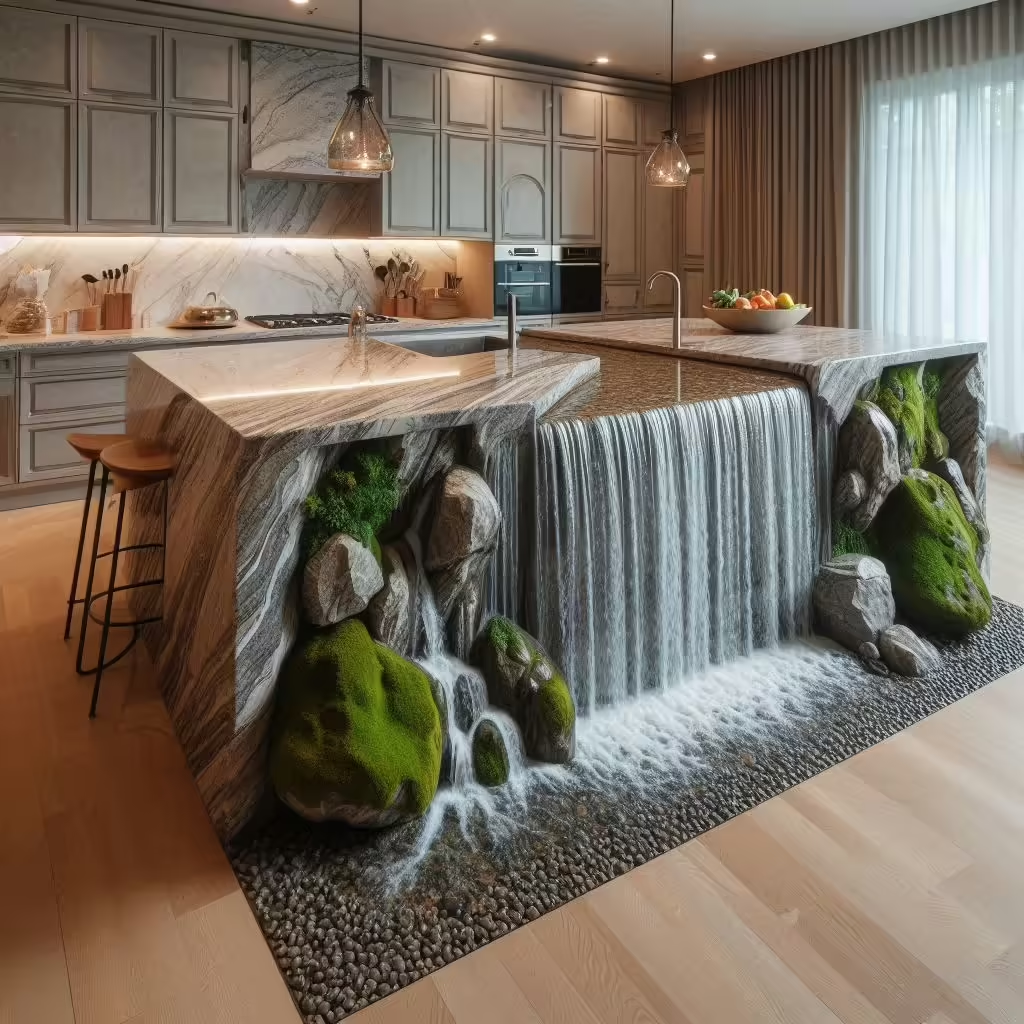
The material you choose for your waterfall kitchen island will significantly impact its appearance, durability, and maintenance requirements. Here are some popular options:
Quartz
Quartz is a popular choice for waterfall islands due to its durability, low maintenance, and variety of color options. It is a non-porous material, which means it is resistant to stains and bacteria, making it an excellent choice for a kitchen environment. Quartz can mimic the look of natural stone while offering a more consistent pattern and color.
Marble
Marble adds a touch of luxury and elegance to a waterfall shaped kitchen island. Its natural veining and unique patterns make each marble island one-of-a-kind. However, marble is a porous material and can be prone to staining and scratching, so it requires regular sealing and maintenance to keep it looking its best.
Granite
Granite is another natural stone that is known for its durability and timeless beauty. It is resistant to heat, scratches, and stains, making it a practical choice for a kitchen island. Granite comes in a wide range of colors and patterns, allowing you to choose a style that complements your kitchen design.
Wood
For a warm and rustic look, consider a wooden waterfall island. Wood adds natural beauty and warmth to the kitchen and can be stained or treated to match your design preferences. However, wood requires more maintenance than stone or quartz, including regular sealing to protect against water and stains.
Concrete
Concrete is a versatile and modern material that can be customized with different colors, textures, and finishes. It can be molded into various shapes, making it an ideal choice for a unique and contemporary waterfall island. Concrete is durable and heat-resistant, but it can be prone to cracking if not properly sealed and maintained.
Design Considerations for a Waterfall Shaped Kitchen Island
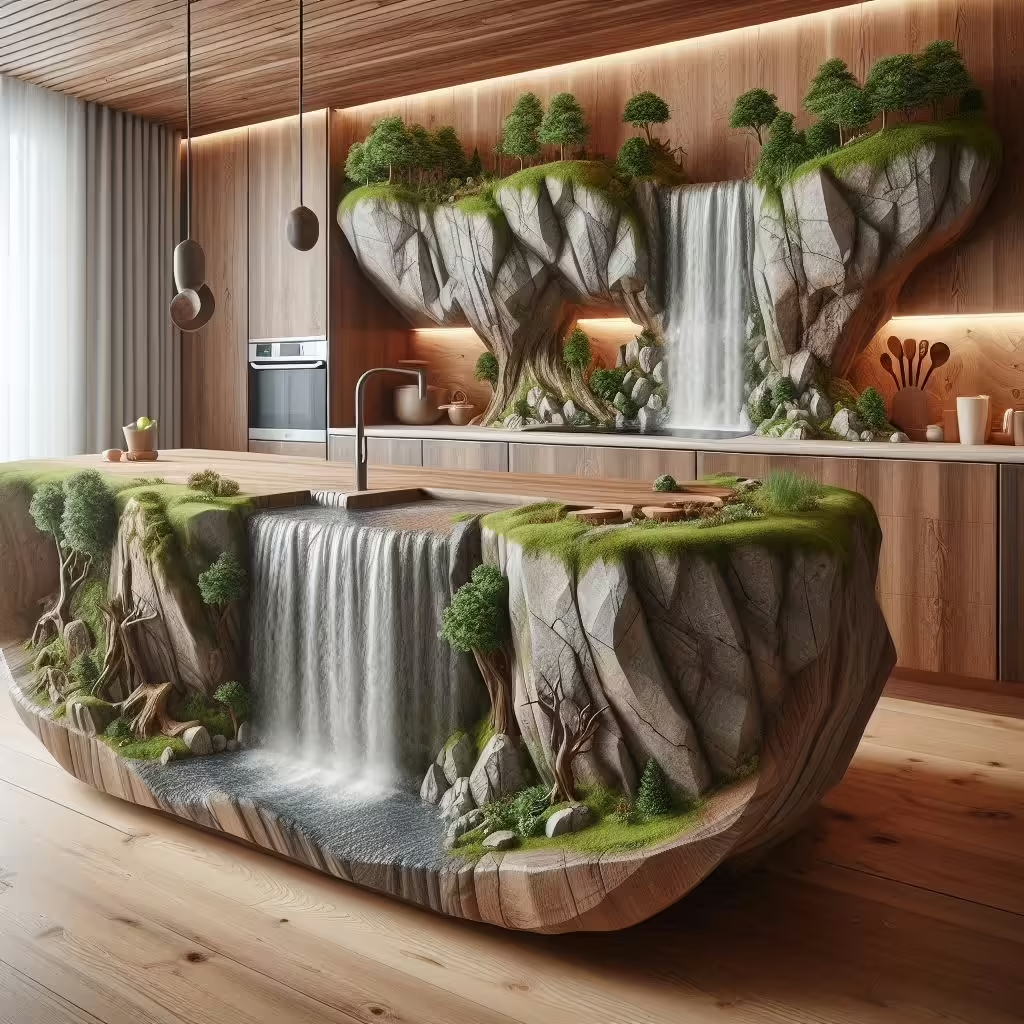
When designing a waterfall shaped kitchen island, there are several factors to consider to ensure it fits seamlessly into your kitchen space.
Size and Proportion
The size of your waterfall island should be proportionate to the size of your kitchen. In a small kitchen, a large island can make the space feel cramped. Conversely, in a large kitchen, a small island may look out of place. Measure your kitchen space carefully and choose an island size that allows for easy movement and functionality.
Island Functionality
Consider how you plan to use your waterfall island. If it will serve as the main food preparation area, make sure it has sufficient workspace and is equipped with essential features like a sink, cooktop, or storage. If the island will be used primarily for seating and dining, ensure there is enough overhang for comfortable seating.
Integration with Kitchen Design
Your waterfall island should complement the overall design of your kitchen. Choose materials, colors, and finishes that blend harmoniously with your kitchen cabinetry, countertops, and flooring. For example, if your kitchen has a modern aesthetic, a sleek quartz waterfall island with clean lines would be an excellent choice. For a more traditional kitchen, a marble or granite island with classic veining might be more appropriate.
Lighting and Accents
To highlight your waterfall shaped kitchen island, consider incorporating proper lighting. Pendant lights are a popular choice for illuminating the island and creating a focal point in the kitchen. Additionally, consider adding accents like bar stools, decorative elements, or open shelving to enhance the functionality and style of your island.
Installation and Maintenance of a Waterfall Shaped Kitchen Island
Professional Installation
Installing a waterfall kitchen island requires precision and expertise, especially when working with heavy materials like quartz, marble, or granite. It’s crucial to hire a professional contractor with experience in installing waterfall countertops to ensure the seams are invisible and the edges are perfectly aligned.
Maintenance Tips
- Regular Cleaning: Clean your waterfall island regularly with a mild detergent and a soft cloth to remove spills and stains. Avoid using abrasive cleaners that can damage the surface.
- Sealing: Depending on the material, you may need to seal your waterfall island periodically to protect it from stains and moisture. Marble and granite, for example, should be sealed every 6-12 months.
- Preventive Care: Use cutting boards, trivets, and coasters to prevent scratches, heat damage, and stains. Wipe up spills immediately to avoid staining, especially on porous materials like marble and wood.
Incorporating a Waterfall Shaped Kitchen Island into Different Kitchen Styles
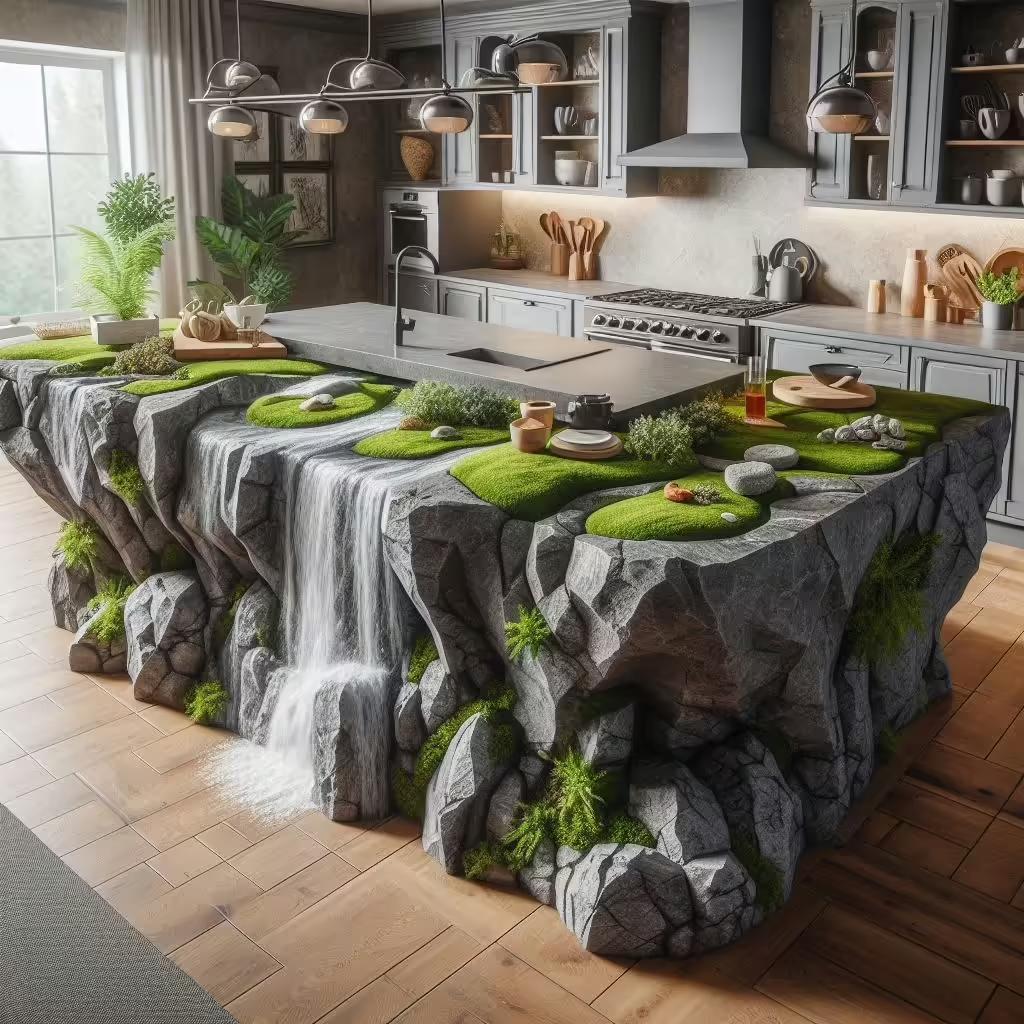
Modern Kitchens
In modern kitchens, a waterfall shaped kitchen island with clean lines and a minimalist design can be a stunning focal point. Opt for materials like quartz or concrete in neutral colors such as white, gray, or black to maintain a sleek and contemporary look. Pair the island with minimalist cabinetry and stainless steel appliances to complete the modern aesthetic.
Traditional Kitchens
For a traditional kitchen, choose a waterfall island with a classic material like marble or granite. The natural veining and rich colors of these stones can add elegance and warmth to a traditional space. Consider adding decorative elements like corbels or moldings to the island to enhance its traditional charm.
Rustic and Farmhouse Kitchens
In rustic or farmhouse kitchens, a wooden waterfall island can add warmth and character. Choose reclaimed wood or a distressed finish for a weathered and cozy look. Pair the island with farmhouse sinks, open shelving, and vintage lighting to create a charming and inviting kitchen space.
Transitional Kitchens
Transitional kitchens blend elements of both modern and traditional design. In this style, a waterfall island made of a versatile material like quartz or granite can serve as a bridge between the two aesthetics. Choose a neutral color palette and combine modern fixtures with traditional cabinetry to create a balanced and harmonious kitchen.
Creative Design Ideas for Waterfall Shaped Kitchen Islands
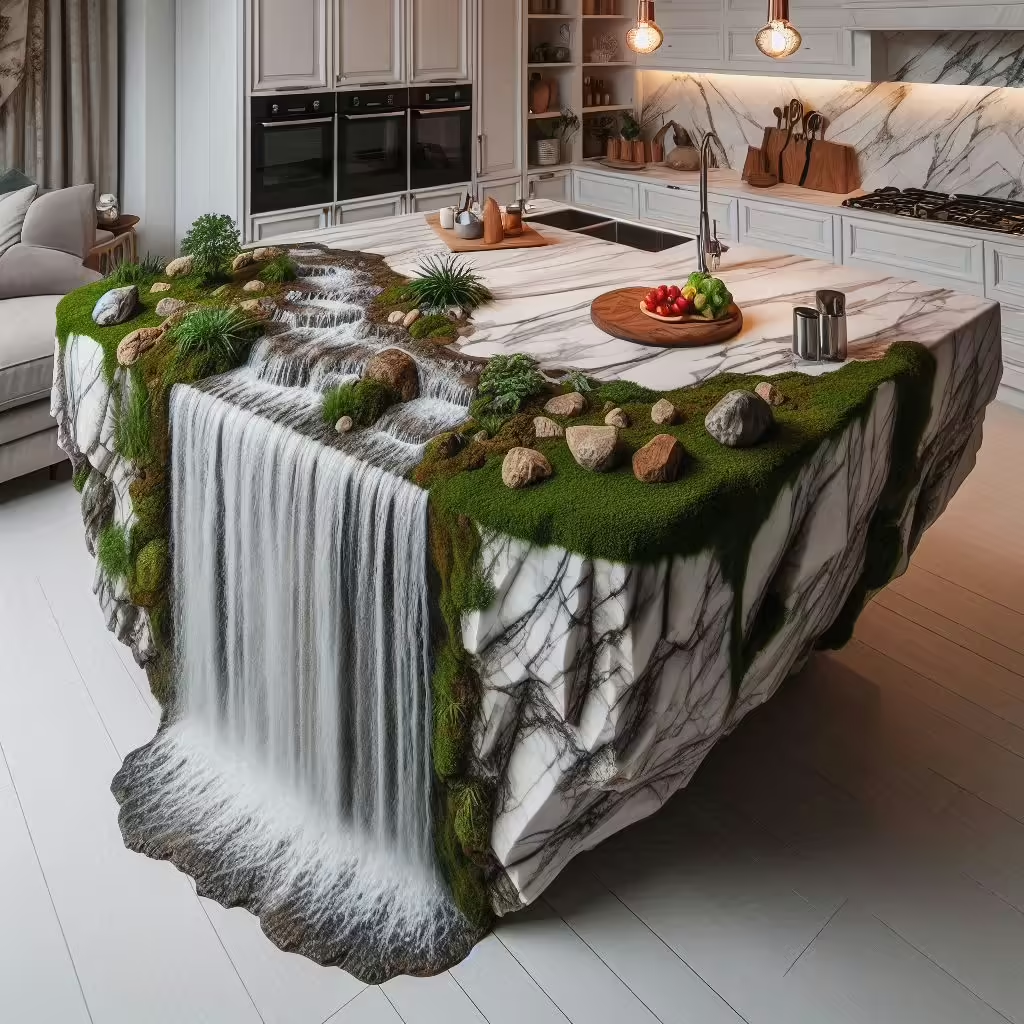
Mix and Match Materials
A unique way to personalize your waterfall shaped kitchen island is to mix and match materials. While many islands feature a single material that wraps around the sides, you can add contrast by combining different textures and colors. For instance, you could pair a sleek quartz top with wooden waterfall sides to bring warmth and texture to a modern kitchen. This design choice adds visual interest and allows you to incorporate various elements from your kitchen into the island.
Incorporate Open Shelving
Integrate open shelving into the sides of your waterfall island for a stylish and functional design. This approach provides additional storage space for kitchen essentials or decorative items like cookbooks, plants, or serving ware. Open shelving can make your island a central piece of kitchen decor, adding personality and a practical storage solution to your kitchen layout.
Add a Built-In Breakfast Bar
If you love the idea of casual dining, consider extending the countertop of your waterfall island to create a built-in breakfast bar. This can be achieved by designing an overhang on one side of the island, allowing for stools to be tucked underneath. This setup not only enhances the functionality of your kitchen by providing a space for quick meals and gatherings but also adds to the overall sleek appearance of the island.
Integrate Appliances and Fixtures
For a seamless and efficient kitchen, integrate appliances such as a cooktop, dishwasher, or wine cooler into your waterfall island. Incorporating these elements within the island design keeps your kitchen streamlined and accessible. You can also include a sink with a stylish faucet to make the island a complete work center, perfect for meal preparation and clean-up.
Play with Color and Patterns
Waterfall kitchen islands don’t have to be neutral. You can make a bold statement by choosing countertop materials with unique colors or dramatic patterns. A dark-colored waterfall island, like black or navy, can create a striking contrast in a light-colored kitchen. Alternatively, opt for a patterned stone, like marble with bold veining, to draw attention to the island and add an element of luxury.
Budget Considerations for a Waterfall Shaped Kitchen Island
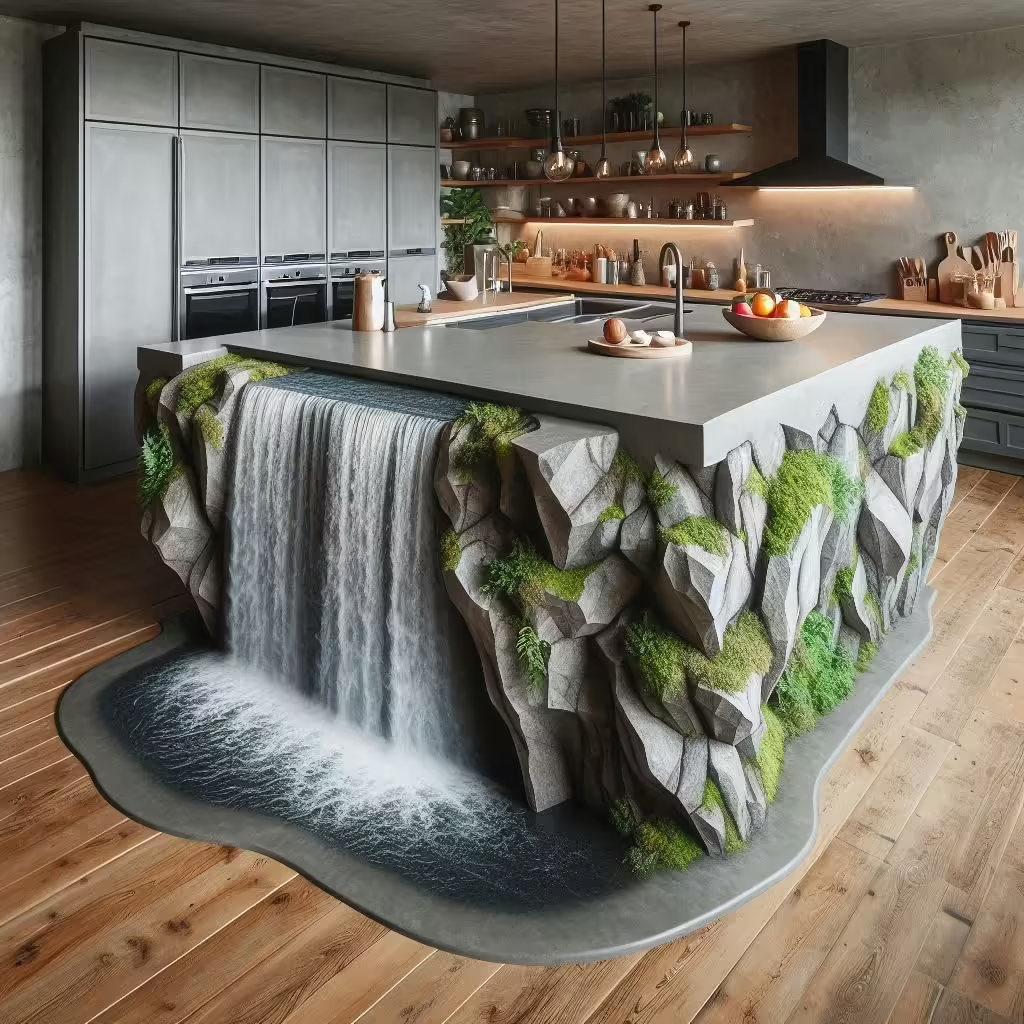
Material Costs
The cost of a waterfall shaped kitchen island can vary significantly depending on the materials you choose. Materials like marble and quartz are often more expensive but offer a high-end look and durability. Granite can be a mid-range option, while wood and concrete may vary based on the type of wood or finish you select. When planning your budget, factor in the price per square foot for your chosen material and the size of your island.
Installation Costs
Since installing a waterfall island requires precision and expertise, professional installation costs should be included in your budget. Complex installations, such as integrating appliances, sinks, or special design features, may increase the overall cost. Always seek quotes from reputable contractors and ensure they have experience with waterfall countertop installations to avoid costly mistakes.
Maintenance and Longevity
While a waterfall island can be a significant investment, it’s essential to consider its long-term value. High-quality materials like quartz and granite offer durability and low maintenance, potentially saving you money on repairs and upkeep over time. On the other hand, materials like marble and wood may require more maintenance and periodic sealing, so factor these ongoing costs into your decision-making process.
Enhancing Small and Large Kitchens with Waterfall Islands
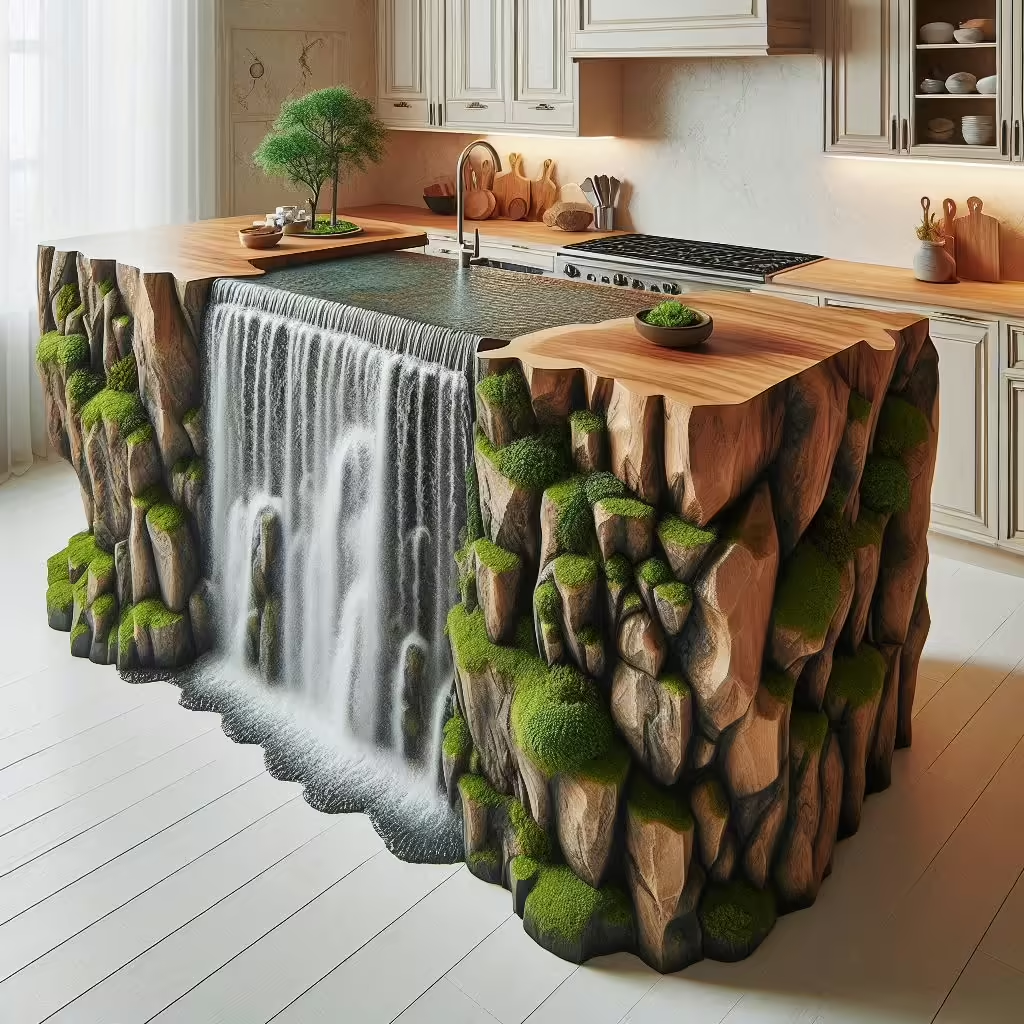
Maximizing Space in Small Kitchens
In smaller kitchens, a waterfall island can be both a stylish and space-saving solution. Opt for a compact island design that provides a functional workspace without overwhelming the room. To maximize storage, incorporate features like built-in cabinets or drawers within the island. The waterfall design can make the kitchen appear larger by creating a streamlined look that draws the eye through the space.
Making a Statement in Large Kitchens
For larger kitchens, a waterfall shaped kitchen island can serve as an impressive focal point. Consider a longer, more expansive island that offers ample space for food prep, cooking, and dining. You can even design a multi-level island with a dedicated area for seating and another for cooking. The extended waterfall edge can enhance the luxurious feel of a spacious kitchen, making it an ideal gathering spot for family and friends.
Lighting and Visual Flow
Whether your kitchen is large or small, proper lighting is crucial for highlighting the beauty of a waterfall island. Use pendant lights to illuminate the island’s surface and emphasize the waterfall edges. In larger kitchens, consider layering the lighting with recessed lights or under-cabinet lighting to create a warm and inviting ambiance. In smaller spaces, reflective materials like polished stone or glass can help bounce light around the room, making it feel more open.
Tips for Maintaining the Beauty of Your Waterfall Shaped Kitchen Island
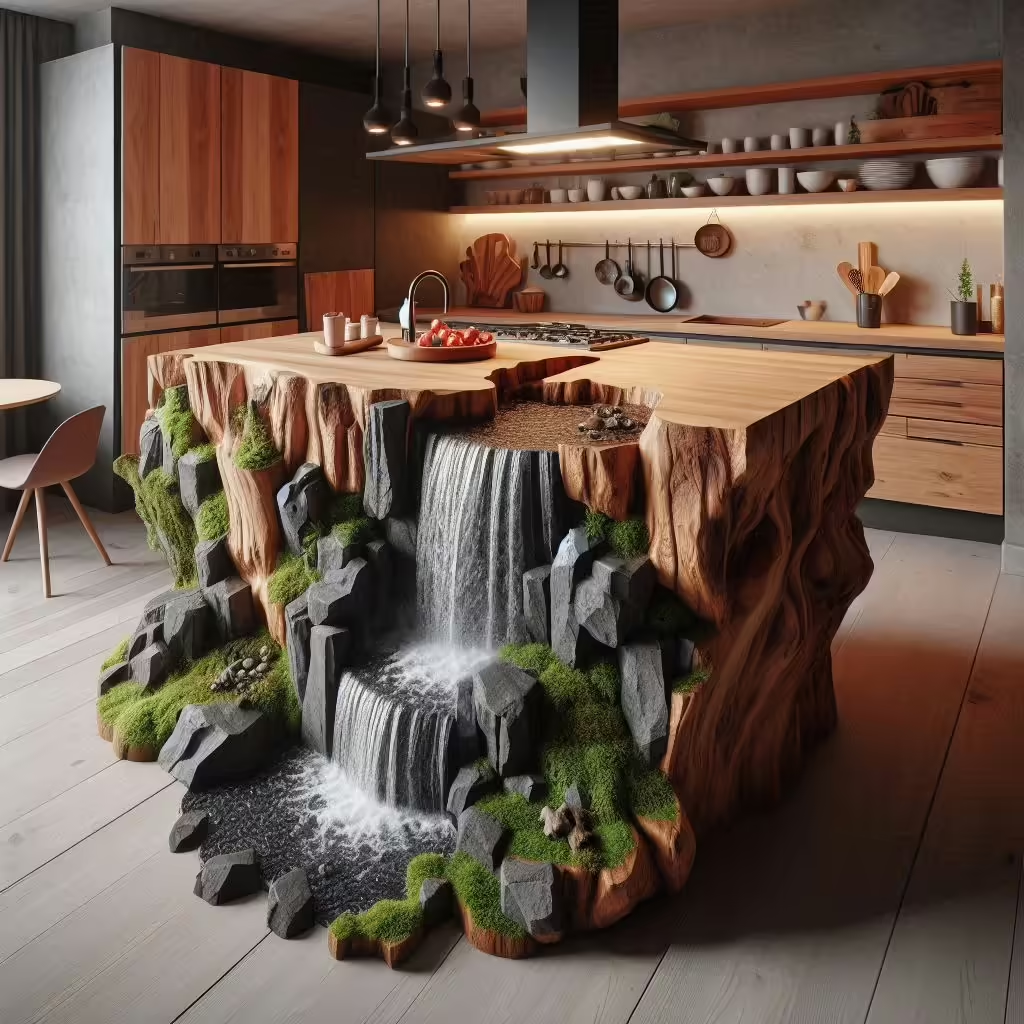
Daily Care and Cleaning
To keep your waterfall shaped kitchen island looking pristine, clean it daily with a mild, non-abrasive cleaner and a soft cloth. For natural stone materials like marble and granite, use a pH-neutral cleaner to avoid damaging the surface. Wipe up spills immediately, especially with acidic substances like lemon juice or wine, which can cause stains or etching on natural stone.
Preventing Scratches and Stains
Protect your island from scratches and stains by using cutting boards and placing hot pots on trivets or heat-resistant pads. This is especially important for materials like marble and wood, which are more susceptible to damage. If you have a wood waterfall island, consider applying a protective finish to enhance its resistance to moisture and heat.
Regular Maintenance and Sealing
For materials like marble, granite, and wood, regular sealing is essential to maintain their appearance and durability. Check with your installer for the recommended sealing schedule and type of sealant suitable for your island. By sealing the surface periodically, you can protect it from stains, water damage, and wear, ensuring your waterfall island remains a stunning feature in your kitchen for years to come.
Conclusion: Elevate Your Kitchen with a Waterfall Shaped Kitchen Island
A waterfall shaped kitchen island offers a unique blend of style, functionality, and durability that can transform your kitchen into a luxurious and inviting space. From enhancing the visual appeal of your kitchen to providing a versatile and practical workspace, a waterfall island is a design investment that pays off in both form and function.
Whether you are working with a compact kitchen that needs a sleek, space-saving centerpiece or a large kitchen that calls for an impressive focal point, a waterfall island can be tailored to suit your needs. By carefully selecting materials, considering design elements, and planning for installation and maintenance, you can create a kitchen island that not only complements your kitchen’s aesthetic but also enhances its everyday usability.
By incorporating creative design ideas, managing your budget wisely, and maintaining your island with care, you can enjoy the lasting beauty and functionality of a waterfall shaped kitchen island. It’s a timeless feature that adds value to your home and transforms your kitchen into a space where cooking, dining, and socializing come together seamlessly.

